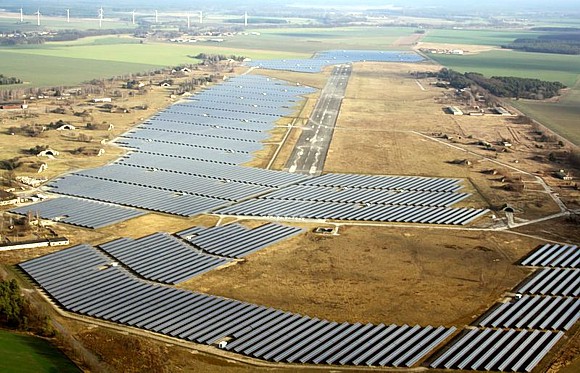The Hanwha Group Now World’s Third Largest Solar Manufacturer With Q.CELLS Acquisition
 November 30, 2012
November 30, 2012  Kyriaki (Sandy) Venetis
Kyriaki (Sandy) Venetis The Hanwha Group has just become the third largest solar manufacturer in the world with its newly completed acquisition of Q.CELLS and the now launch of Hanwha Q.CELLS.
 Q.CELLS solar power plant in Zerbst, Germany. Photo courtesy of Q.CELLS.
Q.CELLS solar power plant in Zerbst, Germany. Photo courtesy of Q.CELLS.
The South Korean conglomerate acquired the bankrupt German photovoltaic developer and manufacturer last August.
The Hanwah Group justified the purchase decision, saying that the bankruptcy filed by Q.CELLS last April was due to a downturn in the global solar industry, the European sovereign debt crisis, and a reduction in German solar subsidy, and promoting that, “Even so, Q.CELLS has remained as a leading global solar player with revenues of EUR 1,354 million and EUR 1,023 million, in 2010 and 2011 respectively.”
Hanwha acquired the following assets from Q.CELLS:
- The headquarters in Bitterfeld-Wolfen, Germany, as well as the research and development operations in Germany.
- The 200 MW cell and 120 MW module manufacturing facilities in Germany.
- The 800 MW cell manufacturing facility in Malaysia.
- Sales offices in the United States, Australia, and Japan.
- 34 patents.
Hanwha says that the total acquisition value is EUR 40 million (around KRW 55.5 billion), and that it has also “effectively negotiated to buy the existing loan agreement (MYR 850 million/around KRW 300 billion) signed between Q.CELLS Malaysia and the Malaysian government.”
The conglomerate added that, “With a strong support shown by the Malaysian government, the loan has been structured in such ways that Hanwha can use the profits generated from Malaysia operations to pay [it] back in the long-term.”
Hanwha touts that with Q.CELLS’ capacity of 1GW added to Hanwha Solar’s existing cell production capacity of 1.3 GW, Hanwha will reach the total annual production capacity of 2.3GW and “become the third largest solar cell manufacturer in the world.”
Hanwha’s 2.3 GW of manufacturing capacity will be distributed across Germany, Malaysia, and China, which the conglomerate sees as a competitive advantage in being able to “supply any region in the world [with solar power], free of trade sanctions.”
Hanwha Q.CELLS’ products will still be developed and manufactured in both the Bitterfeld-Wolfen and Malaysia production plants, and marketed through a global sales network.
Adding to the value of the company, Q.CELLS recently received some notable industry awards and acknowledgements for its technologies.
Last September, Q.CELLS’ received the VDE Quality Tested certificate for managed planning and correct construction for its “standardized block unit for large-scale solar power plants.”
The certificate – awarded by the Association for Electrical, Electronic and Information Technologies – was presented by an independent testing institute at the solar energy exhibition PVSEC in Frankfurt am Main, Germany.
As part of the certification process, the Fraunhofer Institute for Solar Energy Systems drew up a yield expertise confirming the performance of the Q.CELLS’ solar modules, the string, and the entire Zerbst (Germany) solar park.
Q.CELLS expressed confidence that the VDE Quality Tested certificate will provide “investors with the security of knowing a large-scale Q.CELLS solar power plant is a high-quality investment which generates reliable yields throughout its life.”
In July, Q.CELLS also announced that it is the first photovoltaic company whose solar modules have undergone and passed the fourfold potential-induced degradation (PID) test laid out by the TÜV Rheinland testing institute.
Q.CELLS said, “Our products showed excellent results. During the test period, a negative voltage is applied to modules at room temperature, and modules whose performance declines by less than five percent are deemed to have passed.
Q.CELLS added that, “Conventional PID tests take only one week. The tests under the agreed extended conditions lasted for four weeks, meaning they are far more stringent than standard. Q.CELLS submitted several modules for testing in line with these new conditions.
“In the end, TÜV Rheinland announced that all examined Q.CELLS passed the test. According to the assessment parameters used by TÜV Rheinland, none of the solar modules displayed a decline in performance by accuracy of measurement, which proves them as PID resistant.”
Q.CELLS further explained the significance of the findings, saying that one of the most serious negative influences solar modules have to overcome to maintain high-level performance is PID. It can cause a decline in a solar module’s output if there is an excessive negative voltage between solar cell and the ground.
Q.CELLS believes that “the best way to tackle the problem is to integrate PID resistant technology already into the solar cells,” and this is where the company feels it “has a clear competitive advantage.”
With the recent acquisition of Q.CELLS, Hanwha hopes to expand its position as one of the world’s leading providers of photovoltaic technology. Hanwha is already active in the photovoltaic industry with its Chinese subsidiary Hanwha SolarOne, as well as in the insurance, banking, mechanical engineering, chemical, pharmaceutical, and construction industries. Hanwha is one of the largest conglomerates in South Korea, estimating that it has “an annual turnover of USD 31.6 billion (2011).”
Reader comments and input are always welcomed!

Reader Comments